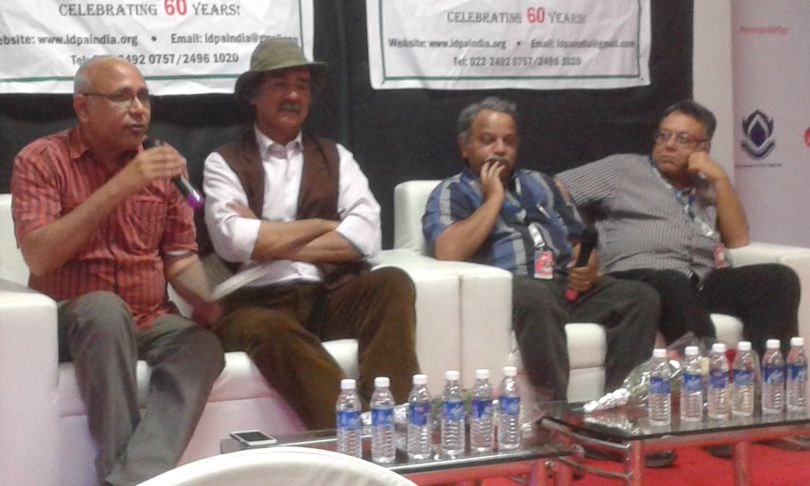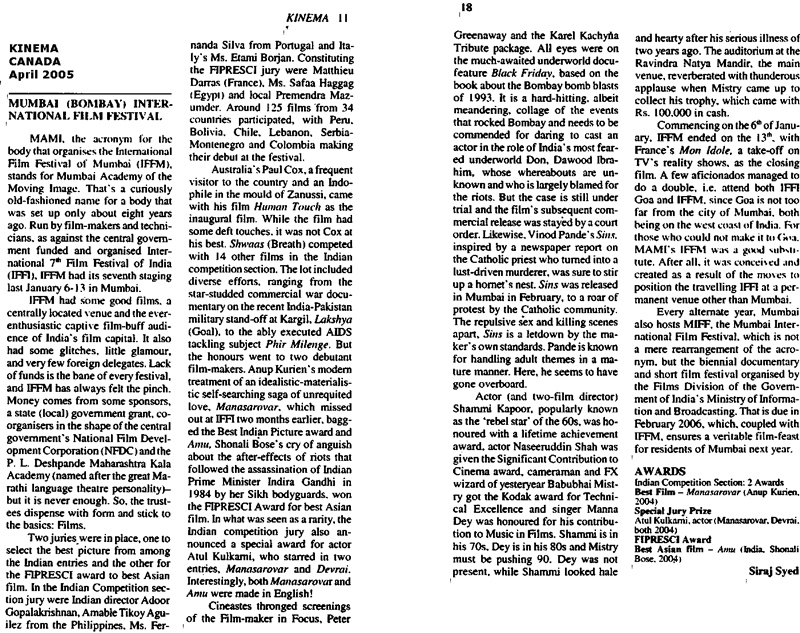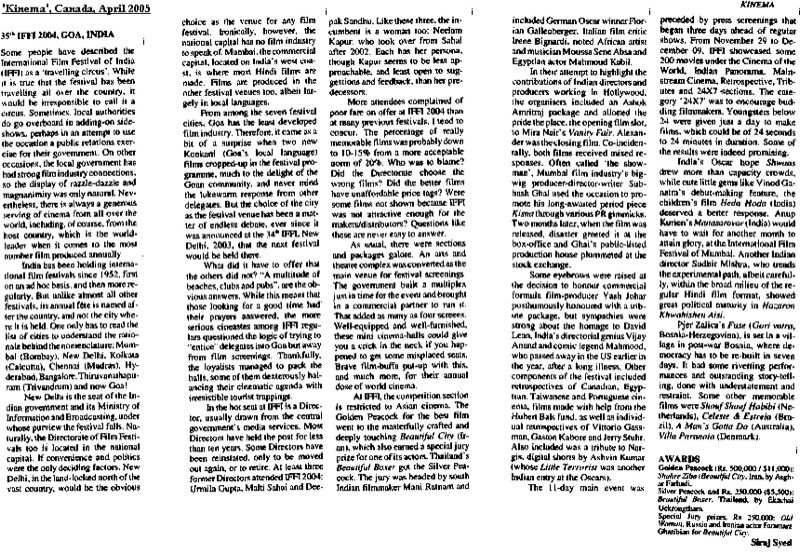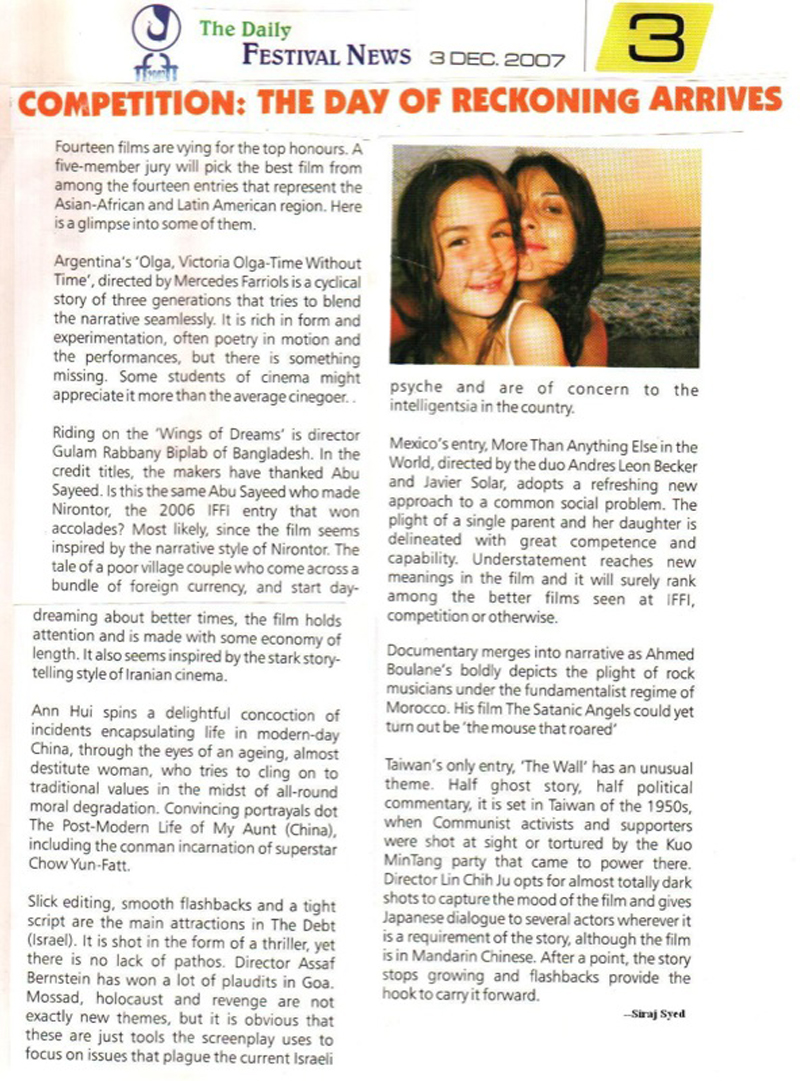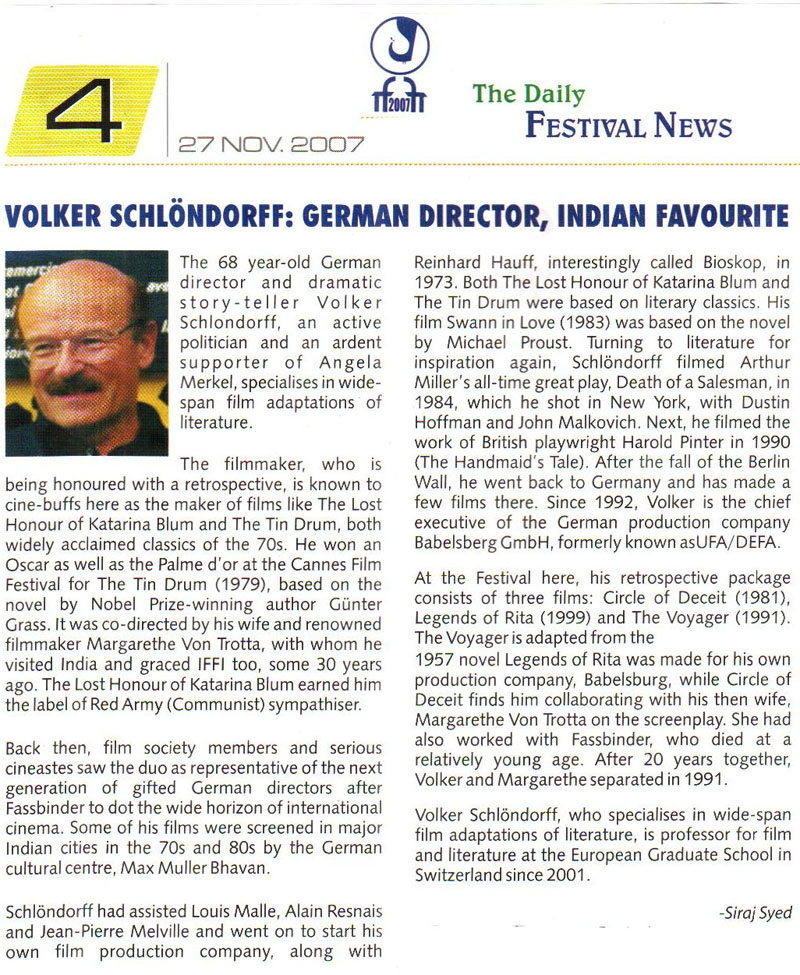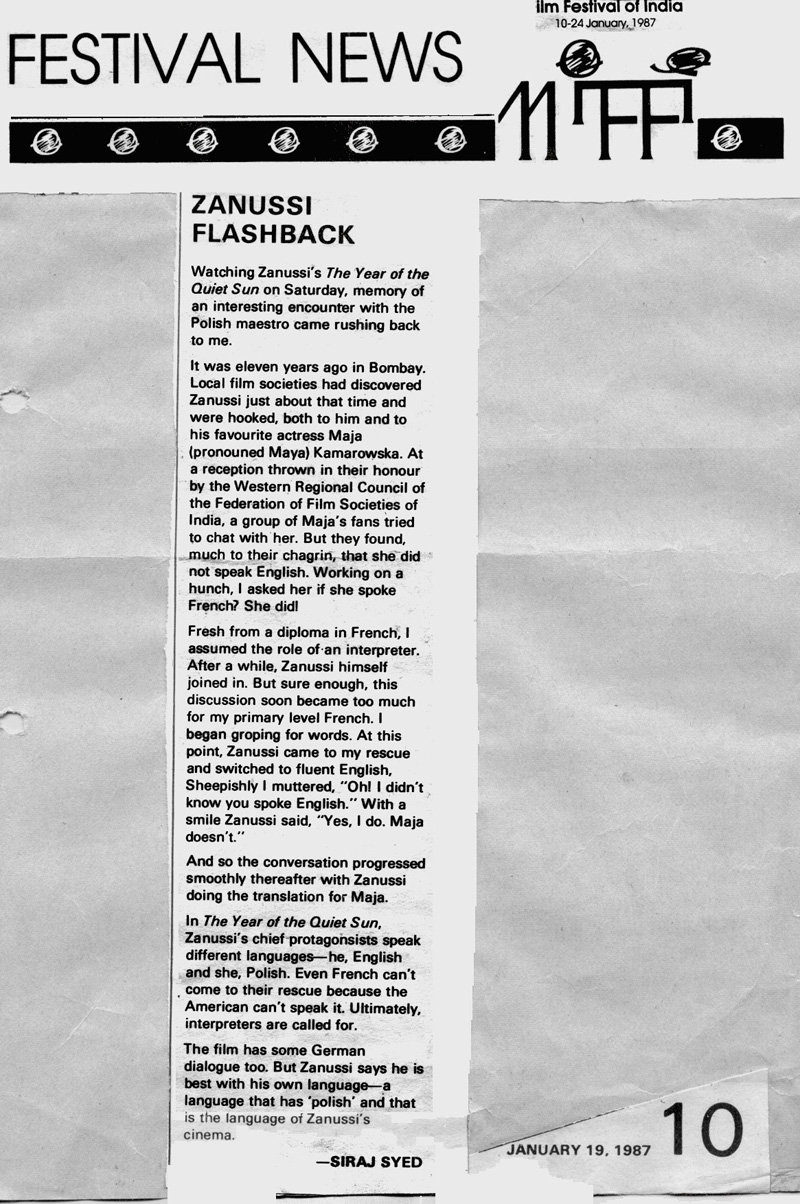|
|
||
|
Pro Tools
FILMFESTIVALS | 24/7 world wide coverageWelcome ! Enjoy the best of both worlds: Film & Festival News, exploring the best of the film festivals community. Launched in 1995, relentlessly connecting films to festivals, documenting and promoting festivals worldwide. We are sorry for this ongoing disruption. We are working on it. Please Do Not Publish until this message disappears. For collaboration, editorial contributions, or publicity, please send us an email here. User login |
Siraj SyedSiraj Syed is the India Correspondent for FilmFestivals.com and a member of FIPRESCI, the International Federation of Film Critics. He is a Film Festival Correspondent since 1976, Film-critic since 1969 and a Feature-writer since 1970. He is also an acting and dialogue coach. @SirajHSyed  Siraj Syed’s IFFI 2016 diary X, Open Forum 6: Finding your way across 2K, 4K, 6K, 8K or 18K
Siraj Syed’s IFFI 2016 diary X, Open Forum 6: Finding your way across 2K, 4K, 6K, 8K or 18K A digital technician who has built theatres (Lightbox in Mumbai, for one)-Neil Sadwelkar, Na Tum Jaano Na Hum producer Vivek Singhania, and Indian Documentary Producers’ Association (IDPA) President Mike Pandey, participated in the last Open Forum of International Film Festival of India 2016, organised by IDPA, at old GMC building, Panaji, Goa, on 27 November. The moderator was film-maker Naresh Sharma, Curator of the Indian Film Festival in Stuttgart, and a cinematographer-cum-still photographer. (Left to right: Naresh Sharma, Mike Pandey, Neil Sadwelkar and Vivek Singhania) Indian films are still made in 2K resolution formats, but international clients are demanding 4K, in most cases. 2K cameras and projectors can be upgraded quite easily, but the progressive upgrading might cost a bit, and the details are sketchy at the moment, we learnt. “Yes, foreign buyers want 4K, even 6K, but history was not shot in 4K. A lot of my footage is not even in HD, yet they buy it for its value. For example, a few minutes of footage I shot of vultures in Ranthambore on primeval equipment is priceless today, because 99.9% of the species is extinct,” were the consoling words of Pandey, to those who wonder whether all the footage they shot over the last 50 years is turning out to be a total loss. Neil reminded us that Indian TV content is still almost entirely SD, not even HD, and 4K projectors are just a handful, though their number is growing. “Platforms like Netflix and Amazon demand HDR 4K, but that should not be an issue, because up-sampling and down-sampling is happening all the time. Shooting specifications can be reduced to match projecting limitations. 35 mm celluloid film was in use for about 50 years as the pivot, but even during that era there were multiple formats in use.” “Though cost is unimportant to big banners like Farhan Akhtar and Karan Johar, even low budget films are shot in 4K these days, and all the editing, post production, etc, is done in the format that suits the production best”, said Singhania, representing the producers’ interests. To encourage better technically quality film products, the government should reduce the duty on import of 4k, 6k and 8k cameras. Meanwhile, the industry bodies, like Film Federation of India (FFI), Films Division (FD), IDPA need to come together to help producers, opined Pandey. He also urged producers not to sell comprehensive rights, as he had himself been able to negotiate good prices for his nature documentaries with Western TV channels, on a per screening basis, retaining all rights. Celluloid film is still the best medium for archiving content, insisted Sadwelkar. “If you don’t access your hard drives for 2-3 years, you might find them blank when you finally do, and all your content will be erased forever. My advice is that you should have back-ups in all possible places: original film, cloud, and Netflix or any other platforms. Sell them even at a low price, so that at least they are preserved,” he concluded.
Picks of the pix HD is usually 1920 x 1080, which could be called 1.92K, or 2K. 2K digital cinema projection is similar to HDTV projection, in terms of resolution. UHD-1, or ultra-high-definition television (UHDTV), is the 4K standard for television. UHD-1 is also called 2160p, since it has twice the horizontal and vertical resolution of 1080p. It has a resolution of 3840 x 2160 (16:9, or approximately a 1.78:1 aspect ratio). Generally 35mm negative should be scanned at 4K (4096 across for Super-35). HDCAM, by the way, is 1440 x 1080 pixels. HDCAM-SR is 1920 x 1080. Ben Hur was shot in 65mm anamorphic, to get a 2.7:1 aspect ratio 1080 and 2K really mean nearly the same thing. In projection of print terms, 35mm is sub 4k, and dependent upon actual print and projector circumstances, sub-HD. A typical cinema projection of a distribution film print will offer no better resolution than an HD digital projection, probably less. IMAX uses dual digital projectors, each with 2K resolution. They claim that this is equivalent to 4K resolution but it really is not. It is still 2K, but twice as bright. 4K digital movie theatres are wide screen theatres, more rectangular than IMAX. IMAX movies are also finished in a 1.9:1 aspect ratio, rather than the regular 2.40:1, which means that the screens in IMAX theatres are taller to support the projected image. 4K was all the rage at NAB 2014, but that's hardly the ceiling for resolution, even in the near future. Even at NAB 2014, you could see 8K acquisition in the Astrodesign and NHK booths, and you may have been wondering, then, how far resolution can really be pushed. For a hint, CMOS sensor design specialist, Forza Silicon, is introducing a new, customisable video-camera platform that can reach "resolutions approaching 200 megapixels," at 60fps. Video professionals don't generally talk about images in megapixel units, which measure the number of pixels in an image (1 megapixel is either 1 million or 1,048,576 pixels, depending on who's counting). But, to put that in perspective, HD resolution is about two megapixels (1920 pixels horizontally multiplied by 1080 pixels vertically, gives you 2,073,600 pixels). 4K is a little less than nine megapixels. Even Red Dragon's vaunted 6K resolution equals only a little more than 19 megapixels. You'd need numbers like 18K--18,000 horizontal pixels-- in order for a 16×9 image to approach 200 megapixels, total. 4K means an incredible level of detail. A 4K picture projected on a cinema screen contains 4096 × 2160 pixels (or tiny dots). That’s over 8 megapixels (million pixels)…or four times the number of pixels on your Full HD TV at home (1920 x 1080 pixels). And you won’t need to worry about pixelation – even if you’re sitting in the front row at your local multiplex, you won’t see a single pixel. 4K TV pictures have a resolution of 3840 x 2160, slightly lower than the cinematic version. Marvel Studios' upcoming Guardians of the Galaxy Vol. 2 will be the first feature film to be shot using 8K cameras, director James Gunn has confirmed.
The sequel to 2014's surprise hit superhero caper, Guardians of the Galaxy, is being shot on the RED 8K WEAPON Vista Vision camera, introduced in April 2015, with the new RED Dragon 8K sensor. The high-spec, high-price camera---they start at $20,000 (£13,700)--is capable of recording full 8K footage (8192 x 4320) at 75 frames per second, in 2.40:1 widescreen. It is, in cinematography terms, a beast. "Very excited to announce Guardians of the Galaxy Vol. 2 will be the first film to shoot using the RED Weapon 8k," announced director James Gunn, on Twitter. 06.12.2016 | Siraj Syed's blog Cat. : Ambiance Ben Hur Farhan Akhtar FD Film Federation of India Films Division Guardians of the Galaxy 2 Indian Documentary Producers' Association James Gunn Karan Johar Lighbox Mike Pandey Na Tum Jaano Na Hum Naresh Sharma Neil Sadwelkar Netflix Vivek Singhania
|
LinksThe Bulletin Board > The Bulletin Board Blog Following News Interview with EFM (Berlin) Director
Interview with IFTA Chairman (AFM)
Interview with Cannes Marche du Film Director
Filmfestivals.com dailies live coverage from > Live from India
Useful links for the indies: > Big files transfer
+ SUBSCRIBE to the weekly Newsletter DealsUser imagesAbout Siraj Syed Syed Siraj Syed Siraj (Siraj Associates) Siraj Syed is a film-critic since 1970 and a Former President of the Freelance Film Journalists' Combine of India.He is the India Correspondent of FilmFestivals.com and a member of FIPRESCI, the international Federation of Film Critics, Munich, GermanySiraj Syed has contributed over 1,015 articles on cinema, international film festivals, conventions, exhibitions, etc., most recently, at IFFI (Goa), MIFF (Mumbai), MFF/MAMI (Mumbai) and CommunicAsia (Singapore). He often edits film festival daily bulletins.He is also an actor and a dubbing artiste. Further, he has been teaching media, acting and dubbing at over 30 institutes in India and Singapore, since 1984.View my profile Send me a message The Editor |

















